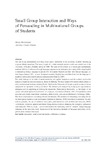Small Grou Interaction and Ways of Persuading in Multinational Groups of Students

View/
Use this link to cite
http://hdl.handle.net/2183/13465Collections
Metadata
Show full item recordTitle
Small Grou Interaction and Ways of Persuading in Multinational Groups of StudentsAuthor(s)
Date
2012Citation
Culture of communication / Communication of culture, 2012: 1685-1694. ISBN: 978-84-9749-522-6
Abstract
[Abstract] The aim of my presentation is to study small-group interaction of the university students role-playing in given debate situations. The study is part of a wider research project which was carried out at the University of Kuopio, Finland, spring of 2006. The goal of this project is to investigate multinational students’ abilities to influence through language, argumentation strategies, and coping skills using English in demanding foreign language situations. For all students English was their first foreign language, i.e. their lingua franca (ELF). In most European countries English has established itself as the language of academic communities and business communication (Jenkins, 2007). The study belongs to the field of social semiotics and applied linguistics and the method used in this analysis is based on discourse analytical theory by Halliday. The data consist of 8 videorecorded debates, in which multinational students studying Public Health at the University of Kuopio played the roles of either ‘proponent’ or ‘opponent’ of the given theme. The debates were analyzed by studying the argumentation strategies used in supporting or refuting the arguments. Participation framework, i.e. the length of the turns of individual speakers revealed the use of power in interaction (Tannen, 1991). The problems which occurred were mainly insufficient vocabulary, difficult topic, and cultural differences (Fairclough, 2006). The object of persuasion is to change beliefs and attitudes. The methods of persuading were analyzed and the small-group dynamics were investigated (Johnson & Johnson, 2009). In addition, multimodal features, such as gestures, the use of assertive voice, pitch, and intonation were studied (van Leeuwen, 2005). Furthermore, emotional appeals and threats being effective tools in enhancing the strength of persuasion were analyzed. With my study I want to demonstrate the increasing need for versatile foreign language pedagogy at the university level. Awareness of the increasing demands of language proficiency set by globalization promotes this need.
ISBN
978-84-9749-522-6





